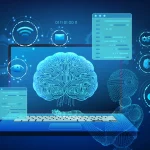In today’s data-driven world, Machine Learning (ML) is no longer a buzzword—it’s a core enabler of innovation across industries. From predictive analytics in healthcare to recommendation systems in e-commerce, ML systems are transforming how businesses operate and how users interact with technology.
But developing a machine learning solution is not just about training a model and calling it a day. It’s a complex, iterative process that spans multiple stages—from understanding the problem to deploying the solution and continuously improving it. This blog breaks down the end-to-end machine learning development lifecycle, giving you a practical understanding of how successful ML systems are built.
1. Understanding the Problem Domain
The first and arguably most crucial step in ML development is defining the problem. This involves working closely with stakeholders to identify a business or operational issue that can benefit from predictive modeling or automation.
For example, in a logistics company, the problem might be: “Can we predict delivery delays based on weather, traffic, and package history?” In an e-commerce business, the question might be: “Can we recommend personalized products to increase user engagement?”
At this stage, clarity on the goal, success metrics, and the type of ML problem (classification, regression, clustering, etc.) is essential. A well-defined problem sets the direction for the entire development process.
2. Data Collection and Preparation
Once the problem is framed, the next step is to collect and prepare data, which is the lifeblood of machine learning.
- Data sources: This could involve gathering data from databases, APIs, web scraping, or IoT sensors.
- Cleaning: Removing duplicates, handling missing values, and filtering outliers.
- Feature engineering: Creating meaningful input variables from raw data.
- Labeling: For supervised learning, data needs to be labeled with the correct outputs.
- Splitting: Usually, the dataset is split into training, validation, and test sets.
According to industry studies, up to 80% of ML development time is spent on data-related tasks. Without clean, relevant data, even the best algorithms will perform poorly.
3. Selecting the Right Model
The model selection process involves choosing a suitable algorithm based on the problem type and data characteristics. Some common ML models include:
- Linear Regression: For continuous output prediction.
- Logistic Regression: For binary classification.
- Decision Trees and Random Forests: For interpretable, tree-based modeling.
- Support Vector Machines: For classification problems with clear margins.
- Neural Networks / Deep Learning: For complex problems like image and speech recognition.
It’s also important to consider baseline models—simple algorithms used as a reference to measure performance improvements. Model selection isn’t always about complexity; sometimes, simpler models outperform complex ones due to overfitting risks.
4. Training and Evaluation
Once the model is selected, it’s trained using the training dataset. This step involves:
- Choosing a loss function (e.g., MSE, cross-entropy).
- Optimizing model parameters using techniques like gradient descent.
- Tuning hyperparameters (e.g., learning rate, regularization).
- Cross-validation to avoid overfitting.
Model evaluation is critical. It answers: How well does the model generalize to unseen data?
Common evaluation metrics include:
- Accuracy, Precision, Recall, F1 Score (for classification)
- RMSE, MAE, R² Score (for regression)
- AUC-ROC (for imbalanced classification)
A model that performs well on training data but poorly on test data likely suffers from overfitting. Techniques like regularization, dropout (for neural nets), or simplifying the model architecture help mitigate this.
5. Model Deployment
After a model passes performance benchmarks, the next challenge is deployment—integrating it into a real-world environment.
Deployment options include:
- Batch processing: Running the model periodically on stored data.
- Real-time inference: Making predictions in response to user actions or API calls.
- Edge deployment: Deploying the model on devices like smartphones or IoT sensors.
Popular tools for ML deployment include:
- Flask / FastAPI: For exposing models as REST APIs.
- Docker and Kubernetes: For containerization and orchestration.
- TensorFlow Serving, TorchServe: For serving deep learning models.
- MLOps platforms like MLflow, Kubeflow, or Vertex AI for managing the full lifecycle.
Monitoring is vital at this stage. Models can suffer from data drift, where real-world data evolves beyond the original training data, causing performance degradation. Continuous monitoring and retraining pipelines are key to long-term success.
6. Post-Deployment Monitoring and Maintenance
Unlike traditional software, ML models degrade over time if not maintained. This is due to:
- Changing data distributions (concept drift)
- User behavior changes
- External factors (e.g., market trends, seasonality)
Best practices for post-deployment include:
- Monitoring predictions and user feedback
- Logging errors and anomalies
- Setting alerts for performance drops
- Scheduling regular retraining cycles
This is where MLOps (Machine Learning Operations) comes into play, combining DevOps practices with machine learning workflows to ensure reliability and scalability.
7. Ethical Considerations and Bias Mitigation
ML systems, if not carefully designed, can propagate or amplify biases present in the data. For example:
- A hiring algorithm might favor certain demographics if the training data reflects historical bias.
- A credit scoring model might discriminate based on zip codes correlated with race or income.
Developers must:
- Audit datasets for representation.
- Use fairness-aware algorithms.
- Test for disparate impact.
- Maintain transparency through explainable AI (XAI) tools.
Responsible AI development is not just a moral imperative—it’s also becoming a regulatory requirement in many regions.
Final Thoughts: The Future of Machine Learning Development
Machine Learning development is evolving rapidly. We’re moving from handcrafted models to AutoML, where machines build models with minimal human input. From standalone solutions to end-to-end ML pipelines powered by cloud platforms. From reactive modeling to real-time AI systems capable of learning on the fly.
To thrive in this dynamic space, developers must embrace a mindset of continuous learning, experimentation, and collaboration.
Whether you’re just starting out or managing enterprise-scale AI projects, mastering the ML development lifecycle—from data to deployment—is your foundation for building impactful, scalable, and ethical machine learning systems.
Want to start building your own ML solution?
If you’re curious about launching a machine learning project or need help integrating AI into your business, feel free to reach out. Whether it’s consulting, model development, or full-scale deployment—we’re here to help.






